It takes science, technology and a little know-how to solve today’s refinish problems, which run the gamut from checking and crazing to blushing and bleeding. With so many variables involved in any paint job, finding the root of the problem often takes a true investigator, a wannabe Magnum P.I. Is poor surface preparation to blame? Did the painter use incompatible paint products or an inadequate reducer? Is improperly cured paint at fault?
Getting to the bottom of sometimes mysterious paint problems can be difficult and a bit exasperating. But we’re all in this industry together, and many of us have confronted and solved the same problem you may be facing today — so it only makes sense to help each other out.
To find out how, I spoke with many painters — some newbies and some veterans — and learned a lot about their resourcefulness in solving assorted refinish nightmares. They have a lot of experience and a long list of tips, tricks and secrets for avoiding common paint problems. Hopefully, you can learn from their mistakes.
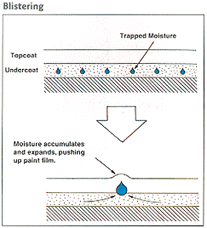
An Independent Outlook
Gary Buer and his son own and operate Springfield Unibody, a repair shop in Springfield, Mo. Buer has been doing collision work since he was 12 years old and has set high standards for other shops in the area. Even though he chooses not to work directly with insurance companies, his business booms because he does sublet work, restoration and tons of referral work that keep him and his staff busy six days a week.
I looked at samples of six jobs that Buer’s team had recently finished and saw no signs of a blend line or finish smudge. Of course, even the best of the best have paint problems sometimes. When asked about fisheye — a common thorn in the sides of painters — Buer says, “We’ve had that problem, too, but we’re very careful to properly prepare our cars, and we don’t mix and match within the paint system.”
Does Buer have any other advice for avoiding fisheye problems? “The single most workable tip you can pass on is this: Windex.”
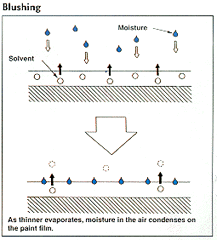
A restoration group who paints “very, very expensive” antique cars shared the Windex tip with Buer many years ago. The procedure: Perform all of the collision work necessary on a repair, keeping in mind quality workmanship and taking adequate precautions to protect the surface before painting. Prior to painting and before you tack down, wipe the surface with a prep solvent. Then spray Windex on the surface, wipe it clean and repeat the process with water as a final wipe-down. Though any glass cleaner will work fine, Buer says Windex works the best.
The capillary action of Windex is aided by surfactants, which make water wetter to penetrate the pores of the refinish area where dirt, silicones and other bad stuff hide from a solvent-only bath. After witnessing the color matching and flawless finishes at Buer’s shop, the Windex trick seems worth a try.
Buer’s specialists also recommend close control of product application to prevent dirt in the finish. To prevent runs and sags, Buer suggests developing good techniques with HVLP spray guns:
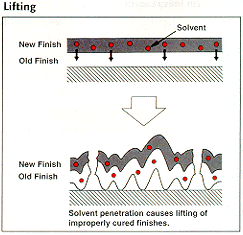
• First, don’t use the gun without cleaning it thoroughly before each job.
• Second, if the gun has a problem such as spitting or dry spray, re-kit it or replace it right away. Buer says more than half of the runs his painters have seen are the result of equipment problems.
• Third, be sure to develop a smooth coating technique, since HVLP guns need a little more time to lay down the finish. High solids work well with the correct thinner and with a good stroking technique during application of the basecoat.
“You can also direct the flip by manipulating the gun and stroking technique when applying metallics,” says Buer. “Don’t mess around with the air pressure or you’ll lose the pigment effect and likely backshade and change the color.”
During my interviews, another technician, Larry Dixon of Jim’s Auto Body and Paint in Forsyth, Mo., offered more preventative measures:
To retard paint drying time, gain a perfect match or help activate the hardening process, the addition of chemicals is necessary. But be cautious, warns Dixon, since chemical overuse has been a big problem during the last decade. Painters often rely on chemicals to aid in film build-up and subsequently destroy the effect of a pearl or metallic paint scheme in the process.
Dixon also had difficulty tinting tri-colors when he first started applying them. “The manufacturers told us it was because we were going through a learning curve,” he says. “Some of us still believe some of the research and development for that product was done by [those of us] in the field. [But we’ve worked through the problems] and they’ve all but disappeared.”
To avoid learning through trial and error as Dixon did, he recommends using exact formulas for mixing.
Though Dixon and his team have solved many of their former paint problems, temperature can still be a troublemaker. Blistering — the formation of bubbles on the painted surface — is caused by humidity or airborne moisture and can only by solved by sanding, prepping and refinishing, says Dixon. Using a better filter in your air system will help eliminate such refinish nightmares.
Direct From a Distributor
Fred Tedrow, owner of Wholesale Auto Paints in Springfield, Mo., says the common problems he used to see with urethanes have all but disappeared thanks to the newest base-clear systems. In fact, he steers customers toward base-clears if he feels they lack experience in blending.
According to Tedrow, many painters don’t blend because color matching is fast becoming a science. The fact that insurance companies won’t pay for blending, which they consider an extra step, may also have influenced the transition toward “total matching” paint systems.
As a distributor, Tedrow hears about a lot of refinish problems from his customers. And many of these problems are a result of the surrounding air. Moisture in the air can create poor gloss or poor adhesion and can produce an uncured finish in some systems. A topcoat that sets too fast can create cloudiness in clears and produce an unacceptable finish.
Other problems — such as poor flow out, poor hide and color streaking — can be related to technique, says Tedrow.
What solutions does Tedrow offer his customers? Fisheye can be corrected before the primer is sprayed on a vehicle. Adding chemical agents after the fact may correct much of the condition, but the durability of the finish may suffer in the long run. This is because the elements that created the fisheye problem, such as silicones and grease, are still embedded under the finish. A good cleaning and strict adherence to prep and handling techniques can all but eliminate fisheye, runs, sags and blistering, he says.
Tedrow also says a clean, well-prepped vehicle, the use of chemical metal treatments and the application of compatible undercoat and topcoat systems will go a long way in preventing other refinish problems.
A Page From the Dealer Notebook
Jack Summit — body shop manager for Vincel Collision Center, Vincel Buick Inc., in Springfield, Mo. — says that most of the high-tech paint jobs his team performs are successful because of the high quality of new paint products. His senior painter, Steve Edwards, says his idea of a paint “problem” has been modified with experience.
“A lot of the things, such as tiger striping, mottling and others, that I looked for solutions to in the form of a chemical quick-fix have been eliminated by paying closer attention to detail,” Edwards says. “If you don’t keep the pigment in your paint in solution and allow it to build up at the bottom of the container, you’ll get a tiger stripe condition.
“The problem of mottling is preventable by using a good flow-through filter and boosting air pressure a little. HVLP paint guns will [work well] if you take the time to be sure you’re using the right nozzle orifice size for the material you’re spraying.”
Though Edwards tries to prevent paint problems in the can, rather than after the application, he admits some refinish glitches still arise. To combat dirt and dust contamination, he suggests avoiding prep work in areas adjacent to the detail shop. To help avoid other problems, he encourages detail people to use products that don’t contain silicone. If you do your prep work carefully and stay within the paint system you select, says Edwards, you can beat most of the ordinary paint problems.
High-Solids Tips and Tricks
Several paint manufacturers offered me advice for avoiding paint problems associated with high-solids systems.
• Solvents and hardeners — Selection of the right product for the spray environment is a must, say experts. Controlling the speed of drying is also essential and is done by selecting the correct fast, slow or medium reducer. Additives such as accelerators or enhancers can quicken dry time, if necessary.
• Spray-gun settings — The advent of HVLP spray equipment means new high-solids levels, which are sometimes as high as 80 percent by volume, are difficult to atomize without high air pressure to move the product onto the vehicle surface. Application problems include slow dry times, runs, sags and solvent entrapment. You can alleviate these problems by using the recommended basecoat-size tip for a high-solids clearcoat.
• Test panels — Spraying a high-solids product requires that siphon, gravity-feed or pressure-pot equipment delivers the paint with enough volume to the nozzle to prevent poor atomization. In addition, use test panels to maintain the accuracy of colors and to develop techniques to ensure proper thickness of the finish. High-solids can go on really thick and be problematic before you’re even aware of it. Practice on test panels before you spray.
• Drying — Many high-solids can fool you into thinking they’re slow-curing and retard drying time. The so-called “hybrid” nature of these sophisticated systems involves chemicals the paint manufacturers are reluctant to reveal much about. What we do know is that they initially appear to dry slowly, but if re-coat or flashover times are ignored, rapid cross-linking can lead to a solvent entrapment problem that will ruin the paint job. In such cases, if possible, it would be wise to use a heat-drying process. In any other case, follow the application, drying and curing schedules of the paint manufacturer to the letter.
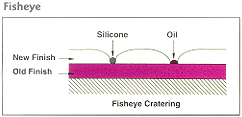
H2O and You
Since waterborne primers still exist in many settings and because the technology is also advanced, paint techs should be aware that with waterborne paint products, the spray environment itself offers the principal control for success or failure of the procedure. Heat, airflow and humidity are factors that are alterable to any degree. Controlling the temperature in the paint booth at a consistent 70 degrees F will put the odds of a quality finish in your favor.
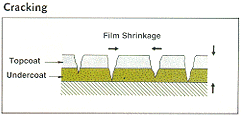
Although a few application formulas call for co-solvents, most reduction with waterborne systems is done with de-ionized water, and controlling the rate of evaporation is a gray area for even experienced users because humidity is an unpredictable variable. Working in a controlled environment spraybooth with help. Waterbornes normally have a viscosity range similar to a medium-solid conventional coating, so start with spray-gun settings for that basecoat application.
Water-based paint poured out of a can is ready to spray. It may appear very thick, but it’ll shear down rapidly while spraying. Painters say that temperatures below 70 degrees F will cause the system to “color trail” — leaving light and dark areas or shading — in some instances. If you’re experiencing such problems, convection-type heaters combined with specially designed airflow systems intended strictly for waterborne systems are the best solution. Cleaning up with ammonia-based cleaners will keep equipment in order and prevent incomplete atomization, which affects both color and flow-out of the finish.
Quit Singing the Blues
So many variables are involved in painting a vehicle — humidity, temperature, product compatibility, curing time, spray-gun settings, etc. — that it’s hard to believe a perfect job is even possible.
If you’ve had your own battles with such variables, you’re not alone. Painters across the country are suffering from and solving refinish problems daily.
Getting to the bottom of those sometimes mysterious problems can be difficult and frustrating. But with a little help from those who’ve been there before, you can better prevent any more flawed finishes. The key is to learn from their mistakes, and avoid making more of your own.
Writer Bob Leone, a retired shop owner and contributing editor to BodyShop Business, is ASE Three-Way Master Certified and is completing qualifications as a post-secondary automotive instructor in the vocational-school system in Missouri.
|
Paint Shop Bloopers Not only do I get to see firsthand their commitment to the industry, but they usually have some amusing tales to share — especially when I visit the paint department. |
|
Deodorant Dilemma After some fact-finding, which included an air-system filter modification and some work with chemical additives, the vehicle was stripped and re-painted again. Expecting the problem to be solved, the crew discovered more fisheye problems, but only on one side of the vehicle. Since the only uncommon denominator in the entire scenario was the tech who’d worked on the affected side, both the representative and Edwards began searching for answers. “It hit us like a ton of bricks,” says Edwards. “The tech had recently switched to a powder deodorant. The representative picked up on it first, admitting he’d run across a similar problem years ago with a single-stage paint job and talcum powder used to dress rubber door insulation for preservation. The tech wasn’t even aware of a possible problem.” Booted Out “We began to carry some tack and added riding boots to our work boot line, since painters in and out of the place were often involved with the school and/or horses,” Bartlett says. “The nightmare started when we started stocking dressings to keep up the saddles and preserve the boots. The dressings had a silicone additive. We went around and around until we figured out that the silicone additive impregnated into some of the work boots was released to the air [during painting]. We knew it was a silicone problem, but we had a hard time finding the connection.” Swimming in Problems |
|
Solving Sags Other reps agree, saying this situation is curable by adding extra reducer to the formula. Be sure to maintain the proper viscosity by checking against standards and using a viscosimeter while reducing. No matter what paint system you use, you may still get runs or dye-back. But if you follow all the instructions on the label — especially with regard to flash and drying times — and control shop temperature and humidity, you’ll produce a quality finish. |













